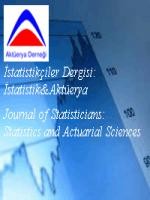Terör Olaylarının İstatistiksel Analizi: Türkiye Örneği
yaklaşımı ile analiz edilmektedir. Çalışmanın amacı; her bölge için en uygun zaman serisi modelini ortaya
Anahtar Kelimeler:
Zaman Serileri Analizi, Türkiye Terör Oranları, Güvenlik, Öngörü
Statistical Analysis of Terror Events: The Case of Turkey
analyzed via time-series approach. The purpose of the study is; to put forth the most appropriate time seriesmodels for each region and make forecasts for the terror events. In the analysis; the terror data (Armed Attack,The Mining, Harassing Fire, Using Explosives, Sabotage and Arson) obtained from official sources coveringthe years 2001-2012 have been used. The stationarity of 5 regions has been tested and the most appropriatetime series model for each region has been determined. The validity of the obtained time series models has beentested and the official data for 2011 have been compared with the forecasts made. As a result, effectiveness ofthe forecasts obtained from the time series models were given.
Keywords:
Series Analysis, Turkey’s Terror Event Rates, Security, Forecast,
___
- Abadie, A., 2004, Poverty, Political Freedom, and the Roots of Terrorism, Harvard University and NBER.
- Akdi, Y., 2010, Zaman Serileri Analizi: Birim Kökler ve Kointegrasyon, Gazi Kitapevi, Ankara.
- Azam, J. P., Thelen, V., 2008, The roles of foreign aid and education in the war on terror, Public Choice. 135, 375-397.
- Bal, A.M., 2003, Modern Devlet ve Güvenlik, IQ Kültür Sanat Yayıncılık, İstanbul.
- Blomberg, S. B., G. D. Hess, A. Weerapana, 2002, Terrorism from Within: An Economic Model of Terrorism, Working Paper, DIW Workshop “The Economic Consequences of Global Terrorism”.
- Bozkurt, H., 2007, Zaman Serileri Analizi, Ekin Kitapevi, Bursa.
- Çilingirtürk, A.M., 2011, İstatistiksel Karar Almada Veri Analizi, Seçkin Kitapevi, Ankara.
- Enders, W., 1995, Applied Econometric Time Series, John Wiley and Sons, Canada.
- Enders, W., Sandler, T., 2000, Is Transnational Terrorism Becoming More Threatening? A Time-series Investigation, Journal of Conflict Resolution, 44(3), pp. 307- 332.
- Fearon, J. D., Laitin, D. D., 2003, Ethnicity, Insurgency, and Civil War, American Political Science Review, 97(1), pp. 75-90.
- Gençtürk, T., 2012, Terör Kavramı ve Uluslararası Terörizme Farklı Yaklaşımlar, Başkent Üniversitesi Stratejik Araştırmalar Merkezi.
- Göktaş, Ö., 2005, Teorik ve Uygulamalı Zaman Serileri Analizi, Beşir Kitapevi, İstanbul.
- Gujarati, D.N., 2003, Basic Econometrics, McGraw-Hill, New-York.
- Gurr, T. R., 1970, Why Men Rebel, Princeton, NJ: Princeton university press.
- İçli, T., 2007, Kriminoloji, Seçkin Yayınevi, 7. Baskı, Ankara.
- Kahn, H., 2012, Determinants of Terrorism in Pakistan: A Time Series Analysis, Master Thesis, Master’s Program in Economics, UMEA University.
- Karamanoğlu, Y.E., 2015, Coğrafi Bölgelerin Suçlar Açısından Kointegrasyon Analizi, 4’üncü Nüfus Bilim Konferansı, Hacettepe Üniversitesi, 5-6 Kasım, Ankara.
- Krueger, A. B., Maleckova J., 2003, Education, Poverty, and Terrorism: Is There a Causal Connection?, Journal of Economic Perspectives, 17(4), pp. 119-144.
- Li, Q., Schaub, D., 2004, Economic Globalization and Transnational Terrorism, Journal of Conflict Resolution, 48(2), pp. 230-258.
- Muller, E. N., Weede, E., 1990, Cross-National Variation in Political Violence: A Rational Action Approach, Journal of Conflict Resolution, 34(1), pp. 624-651.
- Subrahmanian, V.S., Mannes, A., Sliva, A., Shakarian, J., Dickerson, J.P., 2012, Computational Analysis of Terrorist Groups:Lashkar-e-Taiba, Springer, New York.
- Testas, A., 2004, Determinants of Terrorism in the Muslim World: An Empirical Cross-Sectional Analysis, Terrorism and Political Violence, 16(2), pp. 253-273.
- Tilly, C., 1978, From Mobilization to Revolution, Reading, MA Addison- Wesley.
- Yıldırım, J., Öcal, N., 2013, Analyzing the Determinants of Terrorism in Turkey using Geographically Weighted Regression, Defense and Peace Economics, 24(3), 195 -209.
- ISSN: 1308-0539
- Yayın Aralığı: Yılda 2 Sayı
- Başlangıç: 2008
- Yayıncı: Aktüerya Derneği
